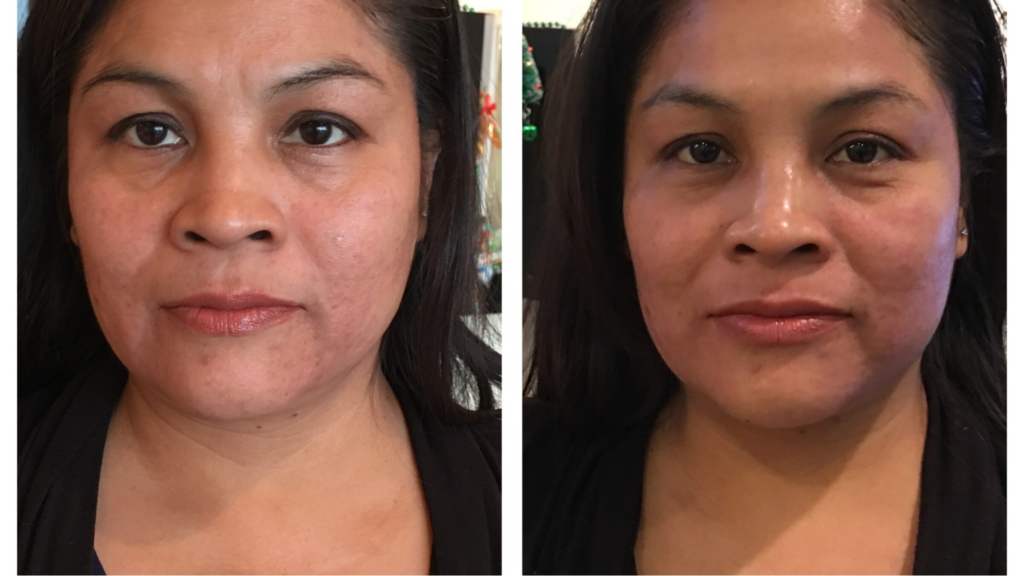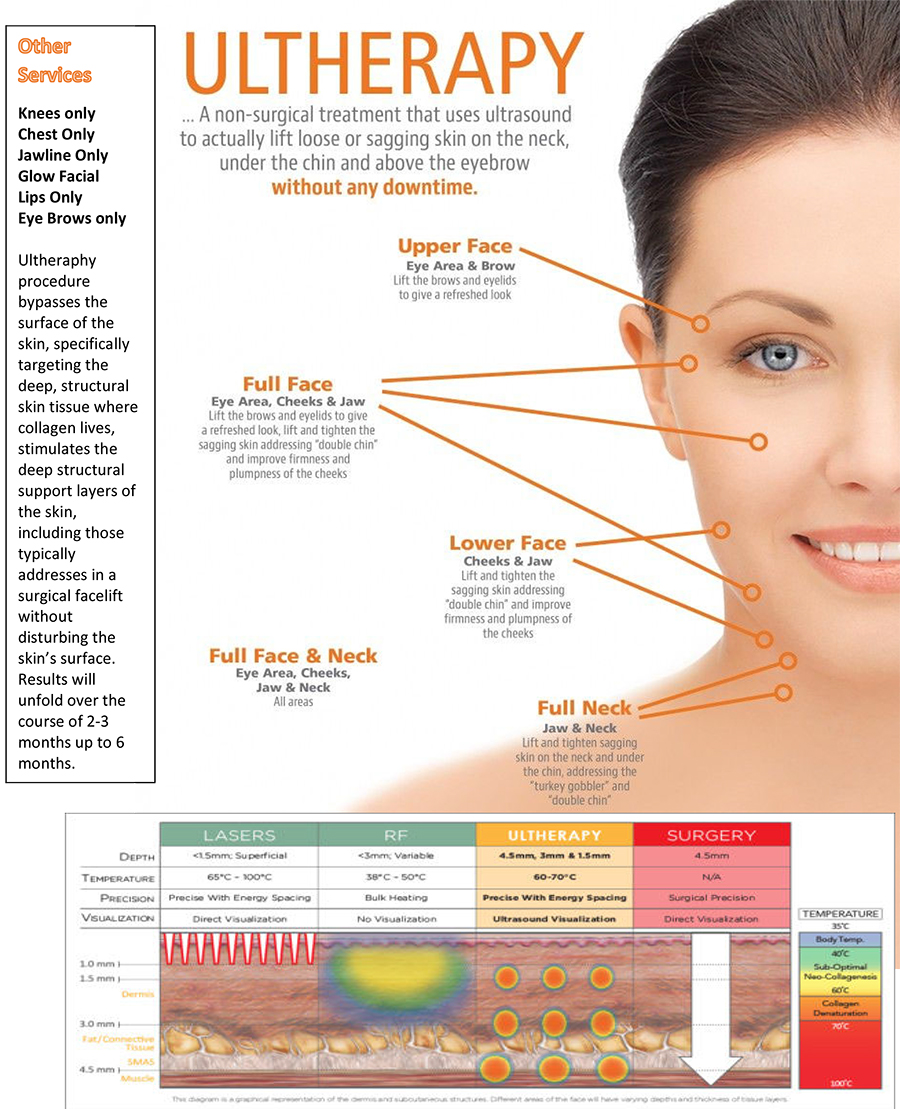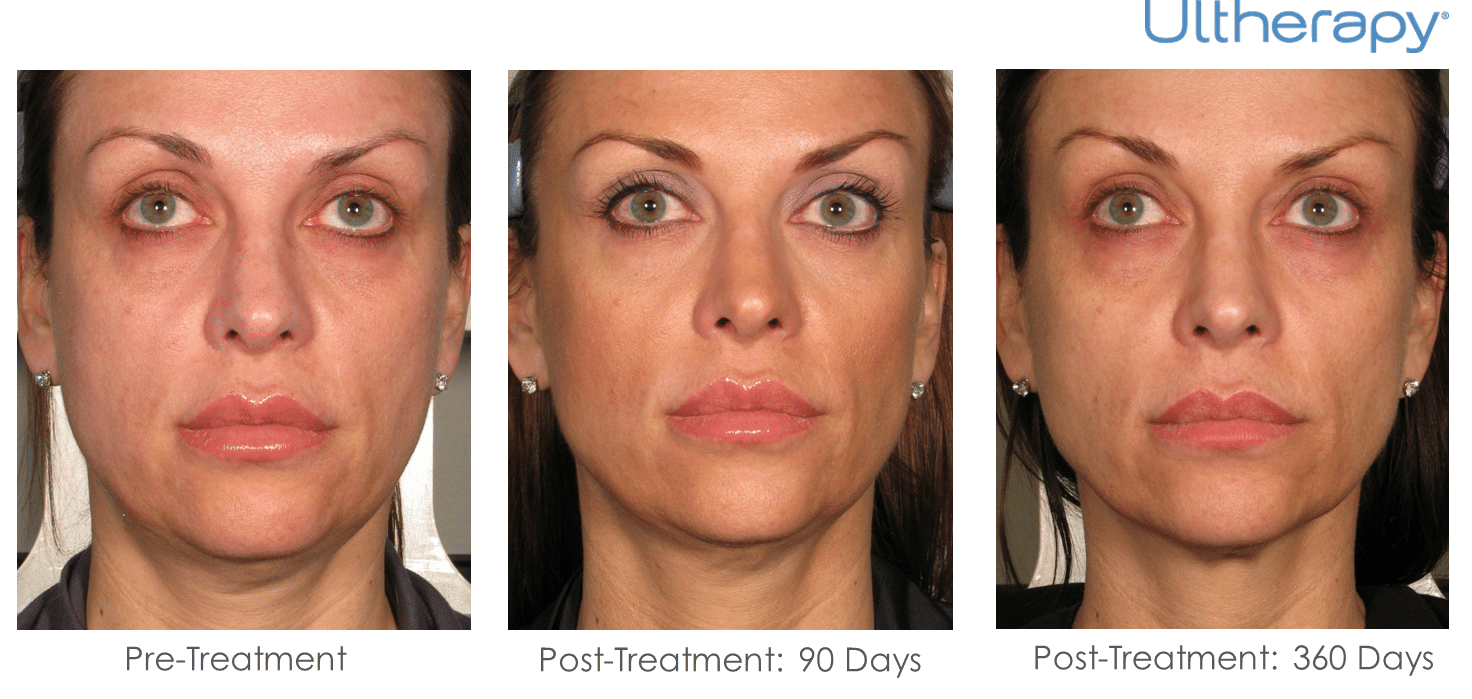Why Ultherapy Could Be Medically Needed: Checking Out the Reasons for a Non Surgical Lift
Ultherapy is gaining focus as a sensible choice for individuals facing skin laxity because of maturing or specific clinical conditions. This non-surgical treatment stimulates collagen manufacturing, offering a service that stays clear of the recuperation time connected with intrusive procedures. As people look for to enhance not just their look yet likewise their total skin health and wellness, comprehending the conditions that warrant Ultherapy's usage becomes vital. What variables add to its clinical requirement?
Comprehending Ultherapy: What It Is and How It Functions
Ultherapy, a non-invasive cosmetic procedure, makes use of ultrasound modern technology to boost collagen manufacturing and promote skin tightening. By delivering focused ultrasound energy deep right into the skin, it targets the foundational layers usually dealt with in surgical facelifts. This procedure motivates the body's all-natural healing action, leading to gradual training and tightening of the skin over time.

Therapy sessions normally last between 30 to 90 mins, depending upon the size of the area being dealt with. While outcomes might not be instantly noticeable, excellent impacts generally show up within a couple of months as collagen remains to establish. Ultherapy deals a compelling non-surgical option for people seeking skin restoration without the need for invasive procedures.
The Aging Refine: Effects on Skin Flexibility and Collagen
Aging certainly brings adjustments that decrease skin flexibility and collagen production, bring about visible indications of drooping and creases. As individuals age, the skin's ability to preserve moisture declines, resulting in a drier and much less resistant surface area. Collagen, a vital protein accountable for skin framework, likewise diminishes, causing the skin to lose its firmness and vibrant look. Variables such as sunlight exposure, environmental contaminants, and lifestyle selections further accelerate this decline in skin quality.
This loss of flexibility and collagen produces a waterfall of modifications, consisting of the formation of dewlaps, growing nasolabial folds up, and a total sagging look. The skin's support group compromises, making it extra at risk to the results of gravity. Numerous people look for treatments like Ultherapy to combat these aging results, aiming to restore an extra vibrant, tight appearance without the demand for intrusive surgical treatments.
Medical Problems That May Advantage From Ultherapy
Ultherapy is increasingly recognized for its prospective benefits in addressing different clinical conditions. Individuals experiencing skin laxity, those in post-surgical healing, and people with chronic skin problem may locate this non-invasive treatment useful. By stimulating collagen manufacturing, Ultherapy can boost skin firmness and enhance general appearance for these groups.
Skin Laxity Problems
Skin laxity can be a considerable worry for individuals experiencing different clinical problems that affect the honesty and flexibility of their skin. Conditions such as Ehlers-Danlos disorder, which disrupts collagen manufacturing, can lead to premature skin aging and drooping. Furthermore, individuals with autoimmune conditions may experience skin modifications that add to laxity. Hormone fluctuations, specifically throughout menopause, likewise play a function in decreasing skin suppleness. Ultherapy, utilizing ultrasound innovation, targets the deeper layers of skin, promoting collagen production and tightening the affected areas. This non-invasive therapy may use a viable option for those seeking to resolve skin laxity resulting from these clinical conditions, improving both appearance and self-esteem without the requirement for medical treatment.
Post-Surgical Recuperation Aid
Post-surgical recuperation can typically present challenges, specifically for people experiencing skin laxity due to medical treatments. Ultherapy functions as a possible help in this circumstance, utilizing ultrasound modern technology to stimulate collagen manufacturing and boost skin rigidity without invasive procedures. Individuals that have gone through surgical treatments such as facelifts, lipo, or other body contouring treatments may discover that Ultherapy boosts their recovery by addressing unequal structure and laxity that can happen post-operation. This non-surgical strategy can lead to improved aesthetic results, potentially lowering the demand for additional surgical treatments. Moreover, it may help reduce discomfort related to the recovery process, offering patients a more all-inclusive recovery experience. Ultherapy can be a useful choice in post-surgical care.
Chronic Skin Disease
For individuals dealing with chronic skin problems such as acne scars, rosacea, or laxity due to aging, non-invasive therapies might use considerable relief and enhancement. Ultherapy has actually become a promising option, utilizing ultrasound modern technology to promote collagen manufacturing deep within the skin. This process can improve skin structure and elasticity, resolving concerns like irregular skin tone and drooping. Particularly, those with rosacea may experience minimized soreness and swelling, while individuals with acne scars can take advantage of improved skin smoothness and general look. Significantly, Ultherapy gives a non-surgical alternative that decreases healing time and threats linked with intrusive treatments, making it an appealing selection for people seeking effective management of chronic skin disease.
Mental Impact of Drooping Skin and Visual Issues
The psychological toll of aging often materializes in the type of drooping skin, which can considerably affect a person's self-esteem and total psychological wellness. Many individuals link youthful looks with power and good looks, resulting in feelings of insufficiency when confronted with noticeable signs of aging. This perceived decrease in appeal can cause social stress and anxiety, withdrawal from social communications, and a raised obsession with one's appearance.
People may feel obliged to seek visual treatments to deal with these problems, as the desire to keep a youthful look can come to be linked with individuality. The psychological results of sagging skin may also lead to anxiety or a diminished lifestyle. Non-surgical choices like Ultherapy arise as possible services, aiming not just to invigorate the skin yet also to restore confidence and a positive self-image, ultimately addressing the deeper psychological ramifications of aging.
Comparing Ultherapy to Traditional Surgical Options
When contrasting Ultherapy to traditional medical choices, considerable differences arise in both cost-effectiveness and recovery time. Ultherapy offers a non-invasive method that often causes lower expenses and very little downtime for people. On the other hand, surgical lifts normally need even more economic investment and a prolonged healing period.
Cost-Effectiveness of Ultherapy

Standard surgical lifts frequently come with considerable in advance costs and prolonged recovery times, Ultherapy presents an engaging option that can deliver comparable results at a portion of the cost. The average price of a medical renovation can range from $7,000 to $15,000, while Ultherapy therapies commonly fall click now between $2,000 and $4,500, relying on the area dealt with and service provider knowledge. Additionally, the lack of considerable pre-operative analyses and post-operative treatment related to Ultherapy even more adds to its cost-effectiveness. This technique not only decreases financial stress however also allows individuals to invest in other elements of their health and well-being. This way, Ultherapy becomes an economically practical choice for those looking for facial rejuvenation without the worries of typical surgery.
Healing Time Contrast
Recovery time is a substantial consider the decision-making procedure for those considering cosmetic procedures. Ultherapy attracts attention as a non-surgical choice that generally calls for very little downtime. Many people can go back to their day-to-day tasks nearly instantly, experiencing just light inflammation or swelling that normally fixes within a few hours. On the other hand, conventional medical alternatives, such as facelifts, often demand an extensive recovery duration. People might encounter several weeks of swelling, bruising, and limited task, with some returning to typical regimens occupying to three months. This stark difference in healing time makes Ultherapy an appealing selection for individuals looking for effective outcomes without the considerable aftercare related to surgical procedure, enabling a smoother change back to day-to-day life.
The Long-Term Benefits of Non-Invasive Treatments for Skin Health And Wellness
As people increasingly look for alternatives to surgeries, the long-lasting advantages of non-invasive treatments for skin wellness end up being much more evident. Therapies such as Ultherapy, chemical peels, and laser treatment offer considerable advantages without the demand for substantial recovery times linked with surgical procedure. Skin tightening treatment KL. Gradually, these non-invasive options can promote collagen production, causing firmer skin and an extra vibrant appearance
Furthermore, routine non-invasive therapies can enhance skin structure, tone, and elasticity, enhancing total skin wellness. Patients frequently experience fewer issues and side effects, making these procedures a lot more appealing.
Additionally, the collective results of regular therapies can sustain and extend visual improvements, enabling people to preserve their preferred look with very little downtime. By prioritizing non-invasive techniques, people can attain lasting outcomes while prioritizing their wellness and health. Ultimately, the lasting advantages of such strategies underscore their growing popularity in modern skincare.
Regularly Asked Questions

How much time Does an Ultherapy Session Typically Take?
An Ultherapy session typically lasts in between 30 to 90 minutes, depending upon the therapy location. Elements such as the individual's specific demands and the level of the treatment can influence the total period.

Exist Any Type Of Adverse Effects Linked With Ultherapy?
Ultherapy can result in side impacts such as temporary soreness, swelling, or inflammation in the treated location - Skin tightening treatment KL. While the majority of people experience very little pain, it is crucial to seek advice from a specialist for individualized advice and possible reactions
Exactly How Soon Can I See Results After Treatment?
Outcomes from Ultherapy typically start to show up within a couple of months post-treatment. The full impacts might remain to establish over six months as collagen production look what i found boosts, resulting in noticeable training and firm of the skin.
Is Ultherapy Suitable for All Skin Types?
Ultherapy is normally ideal for various skin kinds, consisting of lighter and darker tones. Nonetheless, individual skin disease and issues might click here to read influence its performance, making examinations with a qualified professional vital for customized recommendations.
Exactly How Typically Should Ultherapy Treatments Be Duplicated?
Ultherapy therapies are usually recommended every 6 to 12 months, relying on individual skin problem and preferred results. Routine assessments by a qualified professional can aid determine the most effective regularity for maintenance and effectiveness.